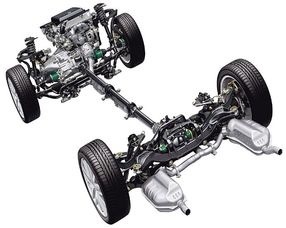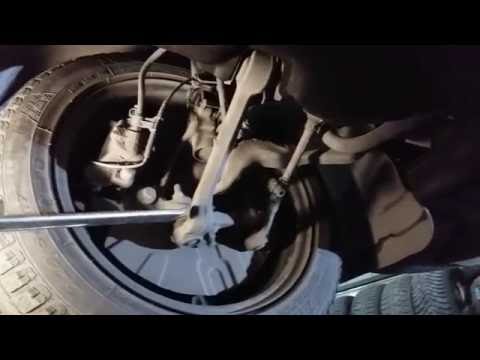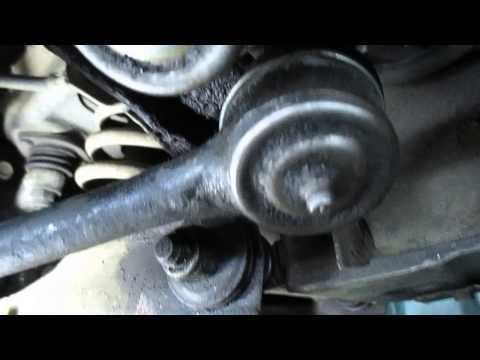
Knocking in the car suspension
Knocking in the suspension sooner or later appears on any car.
There can be a lot of reasons for its occurrence - problems with the chassis, incorrect operation of the car, a frivolous attitude to prevention, and so on.
How to identify the cause of the breakdown and what to do in this case, read in more detail in this article.
Knocking in the front suspension
Unfortunately, impossible to tell by earthat actually knocks. Therefore, when performing self-diagnosis, you need to inspect the shock absorbers, tie rod ends, anti-roll bar, front suspension arm, steering knuckle, silent blocks, ball bearings. A common cause of knocking is the failure of rubber seals. All rubber parts must not be cracked or damaged. If you notice a defect, you should immediately replace them.
Possible causes of knocking and their diagnosis
The cause of knocking can be any part that is part of the suspension. The most common causes of a rattling front suspension are:

Doing your own suspension diagnostics
- wear of the tip of the steering rods;
- shock absorber failure
- wear of ball bearings;
- damage to rubber-metal hinges;
- deformation of the struts of the shock absorbers;
- wear of supports and suspension arms;
- loosening nuts and bolts of fastenings of system nodes;
- wear of the cushion and rubber-metal hinges of the rod;
- development of hub bearings;
- large imbalance of wheels or deformation of wheel disks;
- sediment or breakage of the suspension spring.
Let's take a closer look at these and other causes of knocking in more detail. It is worth starting self-diagnosis by checking the status anthers и rubber sealing parts. If they are damaged, they must be replaced. also look for traces of oil leakage from the shock absorbers.
failure of the suspension arms
Lever silent blocks
Possible cause of suspension knock - breakage of her levers. This is usually accompanied by poor vehicle handling. Check the operation of silent blocks. To do this, use the mount as a shoulder to bend the levers. When it breaks you will see significant backlash.
For repair, it will be necessary to replace the silent blocks. To do this, remove the levers and press the old silent blocks out of the hole. Before installing new silent blocks, lubricate the seat to reduce friction. For one, clean it from dust and dirt.
shock absorber failure
The shock absorber can knock at the top or bottom mount. The reason for this may be loosening of the fixing bolts or increased play in the fixing holes. Visually, wear or breakage of the springs can be determined by the level of the car. If the spring is heavily sagged or broken, this will be seen from the fit of the body. when moving, a broken spring will make a characteristic sound.
damping spring
in order to save shock absorbers, it is recommended fill them with oil of the viscosity indicated by the manufacturer (provided that the shock absorbers are collapsible). In winter, never abruptly start on an unheated car. You can damage not only the internal combustion engine, but also the shock absorbers, since the oil in them is also not warmed up. So you take care of the shock absorbers and increase their service life.
Often the rack can be the cause of knocking. Especially when driving on rough roads (knocking on bumps, bumps) or when the wheel gets into a pit. in order to check the rack, you need to vertically push on fender or hood. With a good stand, the machine smoothly returns to its original position. Otherwise, you will hear a creak and sudden movement.
A loose lock nut can be a possible cause of knocking in the rack. This breakdown can be determined by rocking the car while driving and reducing controllability. In this case, the noise appears randomly. The nut must be tightened, otherwise you risk losing control of the car on the road.
Steering problems

Diagnostics of steering rods on VAZ cars
The noise caused by the steering is similar to that of a defective shock absorber. An indirect sign confirming that the cause of the knock is in the steering is steering wheel vibration и hard knock on bumps, bumps.
The knock from the front, in this case, is the result of the interaction of the rack and the gear moving along it. During the operation of the steering system, the contact gap and the output between the rack and pinion increase over time. The gap is felt when the steering wheel is straight, by slightly rocking the steering wheel to the sides. There is a knock at the point of contact. in order to diagnose this breakdown, it is enough to jack up the car from one of the front sides and shake the steering rods. If at the same time you feel a backlash, then most likely, thud comes from worn bushings. You can find new replacements at any auto shop.
During repairs, garage craftsmen recommend making a mark on the steering shaft in the place where it comes into contact with the gear rack. it is necessary to do this in order to install the shaft during the reassembly of the mechanism by turning it 180 degrees, so the rail can also function normally for some time.
Support for rack
A dull "rubber" sound when driving on rough roads may occur due to incorrect operation of the upper part of the front suspension. This sound can also be called "thumbling". Often the prop can make a creaking sound, and a hard, rubbery thud is mostly audible when rubber seal problems. in order to check it, one person must swing the body, and the second must grab the stabilizer bar with his hand.
It has a rubber base which is a natural shock absorber. However, rubber wears out over time and becomes stiff. Because of this, its flexibility and cushioning ability are lost. Unfortunately, the designs of many cars do not allow you to get to this node and measure the gap between the limiter and the support. However, if your car can do this, then be aware that the distance should be about 10 mm.
Support bearing
Worn support bearing
The sound that a worn thrust bearing makes is similar to that of a damper, but is louder. in order to detect a breakdown, you need to dismantle the front strut. The peculiarity of its production lies in the uneven wear along the perimeter of the body. The largest output occurs when the car is moving straight. That's why knocking is possible with rectilinear movement. If you turn right or left, the knock stops. If you have such a situation, it means that the support bearing has failed in the car.
You can also check it by jacking up one wheel and placing a stand under it so as not to damage your leg. Between the stand and the wheel, you need to put a stick that you need to press in order to check the condition of the support bearing. After that, we put our finger between the nut and the inner part of the support in order to feel the play when the wheel is rocking. If an easy stroke of the rod is noticeable in relation to the inner part of the support, then the seat is broken inside, or the support bearing is out of order (a metallic knock will be heard).
there is also a chance that the nut on the stem just unscrewed. If the knock is dull, then the problem is most likely in the damper, on which cracks can be seen.
Ball bearings
Spherical bearing
On old rear-wheel drive vehicles (for example, VAZs), problems with ball joints are considered a classic cause of knocking in the suspension. The test must begin with hanging on the shock absorber of the car above the wheel where the knock comes from. Beforehand, it is recommended to fix the steering wheel so that it remains in a straight position during the test!
Without rotating the disk, you need to try to shake its opposite parts towards and away from you. The procedure must be carried out in two planes., grasping the left and right sides of the wheel, then the top and bottom. With faulty supports, you will feel play mainly in the second case - loosening the wheel by the upper and lower parts.
Backlash appears due to a gradual increase in output in the lower part of the ball joint, the first sign of which is a creak on a turn, or on bumps. The lubricant gradually disappears, then the output is transferred to the side parts of the support, which leads to the ingress of water into the ball. This can be determined by rocking the wheel sideways with one hand while checking for play on the ball joint itself with the other. The last stage of development, when during the check with the mount, the ball starts to go up and down.
Constant Velocity Joint (CV joint)
If the CV joint is faulty, then while driving it makes a characteristic crackle, especially when cornering. If the CV joint breaks down, it has to be changed, since it cannot be repaired.
From time to time, you need to check the condition of the CV joint boot. If it is dry, then there are no problems with the hinge, but if the anther is oily and dusty, then it is better to replace it. After all, when grease appears on the anther, this may indicate a violation of its tightness, which will lead to water and dirt getting inside. It is recommended to either tighten the clamps or replace the anther with a new one, since cracks most likely appeared in the old one.
Abnormal causes of breakdown
also one reason for knocking can be twisted brake caliper. This is a fairly rare cause, since, usually, the caliper is very secure using locknuts. But if the fixing bolts are nevertheless untwisted, the sound of the caliper, especially when the car is braking, will be very loud, so it is impossible to confuse it with anything. Sometimes, especially if the brake pads are of poor quality, they can make a small and hollow sound. In some cases, delamination of their working surface may occur.
Check integrity caliper guides can be done by lightly pressing the brake pedal while driving. The brake will tighten the calipers, preventing the guides from rattling. In the released state, the knock in the guides will reappear.
The cause of knocks in the front suspension can also occur stabilizer bar bracket. It has bushings with rubber elements in its design. You need to check their integrity.
also one reason for the occurrence of knocking may be the situation when blown airbags. Because of this, a knock appears, outwardly similar to the sound from the running system of the car. So check this option as well. also worth checking Are all nuts and fasteners under the hood tightened?. This is especially true when buying a used car. Unsecured parts may rattle, making a sound similar to the knock of a suspension.
For more information on malfunctions that lead to knocking in the front suspension, see the table below:
| The nature of the knock | Breakdown cause | elimination method |
|---|---|---|
| Thud | The mount to the body of the anti-roll bar has loosened, as well as its struts to the lower suspension arm | Retighten loose screw connections |
| The rubber bushings of the stabilizer, as well as its struts, are worn out | Check for play and replace bushings | |
| The sound of rubber (muffled) | Rack support rubber damper worn out | Replace top strut |
| Hard (metal) knock | Ball joint failed | Replace ball joint |
| hard knock | Steering rod worn out | For replacement traction |
| Broken front wheel hub bearing or loose hub nut | Replace bearing, tighten nut | |
| Crunching or metallic sound in the lower part of the body | The spring broke, the body sagged to one side | Replace the spring immediately |
| Noise when turning steering wheel while driving | CV joint failed | Hinge needs to be replaced immediately |
Knocking in the rear suspension
Diagnosis of the rear suspension is faster because its design is simpler. There can be several reasons for knocking - worn torque rod bushings (if any), loose wheel bolts, loose or broken exhaust pipe mount, broken suspension spring coil, loosening of the short torque rod mounting bracket, recoil valve in the shock absorber, rear shock absorber bushings, released axle shaft, pad spacer bar. also the cause of unknown sounds can be reasons not related specifically to the suspension. For example, items in the trunk, unscrewed "reserve" and so on.
also recommended to check exhaust pipe mount and her general condition. After all, a burnt muffler makes extraneous sounds that a motorist can take for a knock in the rear suspension. In addition, you need to check all the fastening elements of the pipe. If it is not securely fastened, then on rough roads it can make a small and dull knock, which the driver may mistake for problems with the suspension.
With self-diagnosis, you need to check the following components (some of them may not be available on some car models):
Suspension check
- rear suspension guide structure;
- levers (transverse, longitudinal);
- anti-roll bar;
- rear shock absorbers;
- shock-absorbing springs;
- shock absorber cups and brackets;
- rubber bushings;
- rear axle beam;
- compression buffer;
- bearings.
Diagnostics of the guide structure
In the process of performing diagnostics, you need to perform the following actions:
- Check the force and condition of the beam, as well as the levers (if any). Make sure that there is no deformation on these parts.
- Check hinges. They may develop cracks due to wear. This also leads to deformation.
It is worth checking the threaded connections of the flanges at their attachment points. Depending on the make and model of the car, they can be repaired or you will have to buy and install new ones. You need to perform the listed work in a car service or in a garage with a viewing hole.
Suspension springs diagnostics
Despite the fact that the steel from which the springs are made is strong, over time they can fail. Their individual turns break, so the spring stops working normally. To diagnose the spring, it is enough to conduct a visual inspection. In this case, it is worth paying attention to the absence of defects on the coils of the spring, as well as the integrity of the rubber tabs that are located in the places of their installation. If the spring fails, it must be replaced, it cannot be repaired.
Rear shock absorbers
Used shock absorber boots
As in the case of the front shock absorbers, need to diagnose pollen. Replace them if necessary. when inspecting shock absorbers, it is also worth paying attention to the absence of oil leakage from its body. If the shock absorber is collapsible, it is worth dismantling it and disassembling it in order to make sure that the internal elements are in good condition. At the same time, it is worth checking the rubber bushings inside, which often fail.
You will need an assistant to perform the check. You need to rock the rear of the body and see if there is play in the bushings and the characteristic up and down travel of the shock absorber. If there is play, then most likely the bushings have already been developed in the form of an oval - they are to be replaced.
Additional reasons
If you checked the parts listed above, but the knock from the back still remains, you should pay attention to the following things:
- Stopping support. Here they act, as in the case of the front suspension. When it is skewed, the caliper will make a loud sound, so diagnosing this breakdown is not difficult.
- Hub bearing. You need to jack up the whole car or just the wheel you want to check. When rotating freely, the bearing should not make noise, knocks or squeaks. When checking, it is possible to rub the brake pad against the disc, the sound of which is very similar to a squeak. Therefore, when diagnosing, be careful.
The table below shows the main causes of noise in the rear suspension:
| The nature of the knock | Breakdown cause | elimination method |
|---|---|---|
| Deaf thud when hit in pits or bumps | Broken rear shock absorbers | Repair shock absorbers, if not repairable - replace with new ones |
| Constant thud when driving in a straight line | Weakened shock absorber mounting, wear of the bushings in the eyes of the rear shock absorbers | Tighten the shock absorber bolt and nut, replace the bushings in which wear has already appeared |
| A dull thud when rocking the body while driving on a rough road | Damaged bushings in rear suspension arms | All rubber bushings are replaceable |
| Metal knocks, and sagging of one side of the body | Broken or broken spring | Replace the spring with a new one |
| Deaf, strong knock (breakdown) in the rear of the suspension | The buffer collapsed, the breakdown of the rear suspension increased | need to replace a torn or worn buffer |
Hack and predictor Aviator
A knock in the front or rear suspension tells the car owner that a diagnosis needs to be made. Therefore, carry it out as quickly as possible so that an innocent knock, it would seem, of some kind of bushing does not turn into a repair of a broken suspension. And in order to encounter a small and dull knock in the suspension as rarely as possible, we recommend that you select the correct driving mode, especially on uneven country roads and poor asphalt roads. So you will save the car from repairs, and your wallet from additional waste. You can watch the video below for more information on diagnosing knocks in the car's suspension.

How to find a knock in the suspension - what and how knocks?
